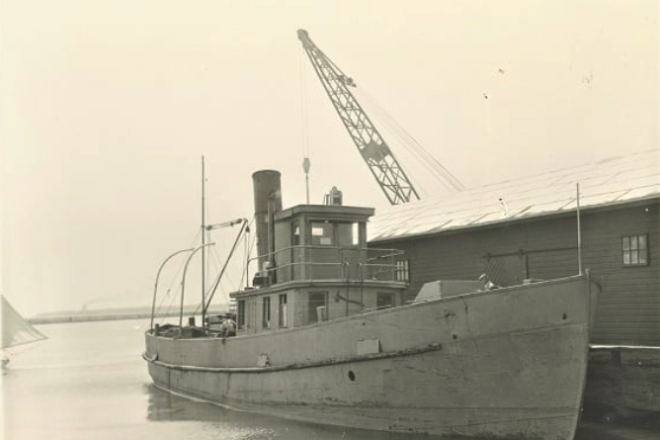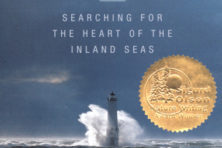Rum Runners on the Great Lakes
- Share
- Tweet
- Pin
- Share

The Story of One of the Largest Liquor Busts on the Great Lakes
“Rum runner” is not a term that’s likely to come up in conversation today, but during Prohibition – the period between Jan. 17, 1920, and Dec. 5, 1933, when the 18th Amendment to the U.S. Constitution outlawed the production, transportation and sale of alcoholic beverages – almost anyone could have told you what (and maybe who) a rum runner was.
The term was first used to describe those who smuggled rum into the U.S. from the Caribbean islands, and among the most infamous of these was Bill McCoy. While smuggling rum from Bimini and the Bahamas, he was one of the first to begin the practice of taking his ship, the Tomoka, to the three-mile limit of the Prohibition jurisdiction, where other boats met him to take the contraband ashore.
The Tomoka, like other rum runners’ boats, was outfitted to defend against anyone who tried to stop it. In the early days, these boats often had the advantage of being faster and better armed than the Coast Guard vessels that pursued them.
Although McCoy was caught in 1923, his legend has survived in a term that’s still in common usage today. He was known as a “reliable” rum runner, whose product was not mixed with anything else – and hence, it was “the real McCoy.” And though smugglers expanded their business to include whiskey, champagne, gin and anything else with alcohol content, the rum runner term stuck.
Rum runners were also often known as “bootleggers,” a term first used in 1889 in Omaha to describe men who hid bottles of alcohol in their high boots to carry it to reservations for illegal sale to American Indians.
Even in quiet Door County, local newspapers carried stories about dangerous chases and confrontations between the Coast Guard and the rum runners who were attempting to evade them to transport their illegal cargo into the country.
On Dec. 9, 1927, for example, the Advocate carried a story about three officers who were killed during a gun battle when Coast Guard boat No. 24 captured a rum runner 30 miles off Fort Lauderdale.
Even the movies picked up the theme. On May 17, 1930, the Door Theatre was showing Night Ride, in which Edward G. Robinson played a rum runner, gunman and racketeer.
But those who might have been interested in seeing the movie had much more excitement taking place right here in Door County. On May 8, 1930, a small steamship had left the Port of Goderich, Ontario – a town on Lake Huron – for its second run of the season. It was bound for Green Bay (and ultimately, it was assumed, to Al Capone in Chicago).
Prior to the steamship’s departure, two U.S. customs agents, presumably with permission from the Canadian government, had been hidden on the lake bank, watching with field glasses, while several men loaded boxes, burlap bags and barrels from a freight train car onto the boat. The agents later reported that the men who loaded the ship left and later returned with six other men who boarded and took the boat out of the harbor, escorted by two speedboats.
The Coast Guard in Chicago was notified that the tramp steamer Amherstburg 18 had left Goderich with a load of illegal liquor. The Coast Guard and customs officials searched for the boat for a week, and Capt. Matty Jacobson of the Plum Island Coast Guard Station notified his lookouts on St. Martin and Rock islands to watch for suspicious boats.
It was not a small craft they were keeping an eye out for. Built in Norway in 1895, the Amherstburg 18 was 86 feet long, with a gross weight of 93 tons. The owner of the vessel – of British registry – was listed as John S. McQueen of Canada. (Unsurprisingly, he was later nowhere to be found.)
On May 14, the St. Martin lookout spotted the rum runner off Whaleback Reef, just west of Washington Island. The Coast Guard boat the Bull was dispatched with Capt. Jacobson; W. Reynolds, the boatswain’s mate; and surfmen R. Peters and A. Daubner. They reached the reef at the same time as the Amherstburg 18 and pulled up alongside.
The crew of six – Al Gorman, Frank Clark, Harry Slater, George Wilson, Edward Benson and Albert Jackson – offered no resistance. All except Jackson claimed to be American citizens. It was later discovered that Jackson was English, and his legal name was Alfred Williams. Wilson, a Canadian, was actually named Bertram Barwick.
The boat, with crew aboard, laid up overnight in Washington Harbor and was moved the following morning to the Goodrich Transportation Company dock in Sturgeon Bay. Carl Young, deputy director of customs in Green Bay, arrested the crew members, who were taken to the Door County Jail until two deputies from Milwaukee arrived with warrants from U.S. Commissioner John Watermolen.
Word had spread quickly about the event, and reporters from several major newspapers were on hand when the crew was taken from the boat to the county jail. This was, obviously, big news. A photographer from the Chicago Daily News booked a flight to get to Sturgeon Bay in time to get a picture of the men, who tried to hide their faces.
Afraid that the liquor on board might be stolen, officials moved the boat to the Coast Guard station in the canal. The following day, Capt. William Betts of Sturgeon Bay; his son, Everett; and several Coast Guard members took the boat to Milwaukee, where the illegal cargo was moved to a federal warehouse.
A few days later, the six crew members were transferred to the Brown County Jail in Green Bay and appeared before Commissioner Watermolen, who charged them with illegal importation and assisting to import liquor into the United States.
They were held on a joint bond of $50,000. (If that sounds low, consider that today it translates to nearly $800,000!)
The following week, they were transferred to the Milwaukee County Jail for a hearing on May 28, 1930. Williams and Barwick took the stand in their own defense, and an attorney entered a plea of not guilty for all six men.
A grand jury hearing, originally scheduled for October, was postponed until Jan. 23, 1931, when all of the men pleaded not guilty. Barwick testified that the six of them were hired at the last minute by three men, one of whom they knew only as “the captain,” and that they didn’t know what the cargo was until the boat was well underway. They claimed not to know the name of the captain – who, they said, had escaped two hours before they were captured, along with the chief engineer and another “well-dressed man,” on a speedboat that the Amherstburg 18 had been towing.
The five crew members who faced trial on Jan. 23 were found not guilty. Al Gorman failed to appear and forfeited his bond. Capt. Jacobson, who represented the Coast Guard at the trial, was quoted as saying, “They are darned nice fellows, all of them. We had no troubles, and they behaved like gentlemen.”
However, one news story, citing the crew’s inability to name the boat’s officers, observed that “clearly the crew of the Amherstburg 18 suffered from a deplorable lack of curiosity combined with poor interpersonal skills.”
It was discovered during the trial that the Amherstburg 18 was stolen property, having been, in a former life, the legendary rum-running tug Geronimo, which had been seized by U.S. marshals in May 1928 near Windsor, Ontario.
In December 1929, the Geronimo “mysteriously” became unmoored from the dock and drifted back across the Detroit River to resume life as a rum runner. The cargo, described as 4,000 cases and barrels of Canadian beer and ale, was valued at $80,000 – equivalent to nearly $1.3 million today. The government disposed of the liquor in Lake Michigan.
In October 1930, a dredging contractor paid a reported bargain price of $400 for the Amherstburg 18 at a government auction in Bay City, Michigan.
Newspapers across Wisconsin and in adjoining states eagerly covered every stage of Door County’s role in Prohibition history as the scene of one of the largest illegal liquor busts on the Great Lakes, and the last before Prohibition was repealed three years later.
Decades on, the tale of the Amherstburg 18 is not forgotten. In October 2016, the Clinton News-Record ran a long story about rum running, noting that “every Great Lakes port was engaged in illegal liquor smuggling. The Detroit River became known as Rum Alley. Throughout Prohibition, the Hiram Walker distillery on the Windsor, Ontario, waterfront defiantly loaded whisky on a daily basis onto ships in plain sight of U.S. customs officers.”
C.W. Hunt, a Canadian history teacher and author, has written two books about Prohibition-era rum runners: Booze, Boats and Billions and Whisky and Ice. A person in the second book observed that “the U.S. was about as dry during Prohibition as the Mississippi mud flats during flood time.”
Based on research in the Door County Advocate; the Door County News; other newspapers in Wisconsin, Illinois, Nebraska and Minnesota; and a 2021 article written by Jim Schwartz for the Wisconsin Marine Historical Society.


